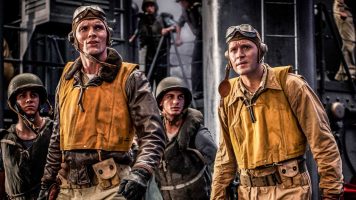In the summer of 1942, the US and Japan fought the Battle of Midway, a sea-and-air engagement that was pivotal in turning the tide of the war in the Pacific. The story was told on film in 1976, with an all-star cast that included Charlton Heston, Henry Fonda, Glenn Ford, James Coburn, Hal Holbrook, Robert Mitchum, Cliff Robertston, Robert Webber, and Robert Wagner. It was loud and bombastic, with dialogue out of the Big War Movie playbook.
The same is true of this 2019 version, with a script that’s just as cliche-ridden, but a roster of modern-day actors that doesn’t come close to qualifying as all-star. Aside from a few recognizable faces (Woody Harrelson and Dennis Quaid), I often had trouble distinguishing between Ed Skrein, Alexander Ludwig, Luke Evans, Nick Jonas, and Darren Criss. None of them speak like real human beings, instead pausing the action frequently for bits of exposition or lines like “Men like Dick Best are the reason we’re going to win this war.” Then they fall back into their old character tropes: Hotshot Pilot Who Doesn’t Follow The Rules Even If It Gets People Killed or Scared Guy Who Somehow Finds His Bravery Under Fire or Gruff Sailor Who Learns A Lesson In Leadership.
Mandy Moore shows up, too, as the wife of one of the naval aviators, but that entire subplot does nothing more than add several minutes to the already bloated two-hour-plus run time of “Midway.” I was reminded of the scenes in “The Caine Mutiny” involving Willie Keith’s fiancé — completely irrelevant to the central narrative. Both women were no doubt inserted into the storyline after some movie executive complained that there had to be at least one woman on the screen, and they couldn’t very well be on board the battleships or in the fighter planes during World War II.
Screenwriter Wes Tooke and director Roland Emmerich (who proved his bombast bona fides with “Independence Day” and “The Day After Tomorrow”) try to cover too much ground, starting during peacetime in 1937 before moving to late 1941 with the Japanese attack on Pearl Harbor. That allows them to show a lot more explosions and computer-generated dog fights but, like the unnecessary home front scenes, distracts from the climactic confrontation to come. While Emmerich has a talent for overblown visuals, he has no touch for the humanity of the people he’s portraying on screen.
The only two side stories that work are the raid on Tokyo by Jimmy Doolittle’s (Aaron Eckhart) squadron of flyers — shot in such an immersive way you feel like you’re in the cockpits with them — and the team of code breakers back at headquarters who decipher the enemy’s messages, figure out their plan, and help devise the trap that leads to the American victory. It’s also interesting to see the inclusion of the perspective of the Japanese commanders, flyers, and sailors (with Etsushi Toyokawa as Admiral Yamamoto, originally played by the great Toshiro Mifune), although they, too, tend to talk in war movie cliches.
I give “Midway” a 4 on a scale of 10.

